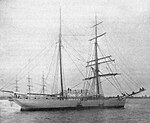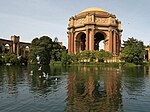Fort Mason Tunnel
1914 establishments in CaliforniaAC with 0 elementsAmerican tunnel stubsCalifornia transportation stubsFisherman's Wharf, San Francisco ... and 10 more
Golden Gate National Recreation AreaMuni MetroProposed public transportation in the San Francisco Bay AreaProposed railway lines in CaliforniaProposed railway tunnels in North AmericaRailroad tunnels in CaliforniaSan Francisco building and structure stubsTunnels completed in 1914Tunnels in San FranciscoUnited States rail transportation stubs

Fort Mason Tunnel is an abandoned single-track railway tunnel in San Francisco which runs under a small hill upon which sits a portion of the old Fort Mason. The tunnel was constructed in 1913 and opened to rail traffic in 1914. The east portal is near the north end of Van Ness Avenue; the west portal feeds onto Marina Boulevard at Laguna Street.
Excerpt from the Wikipedia article Fort Mason Tunnel (License: CC BY-SA 3.0, Authors, Images).Fort Mason Tunnel
Fort Mason, San Francisco
Geographical coordinates (GPS) Address External links Nearby Places Show on map
Geographical coordinates (GPS)
| Latitude | Longitude |
|---|---|
| N 37.8054 ° | E -122.43118 ° |
Address
Fort Mason Beltline Tunnel (Fort Mason Tunnel)
Fort Mason
94123 San Francisco
California, United States
Open on Google Maps









